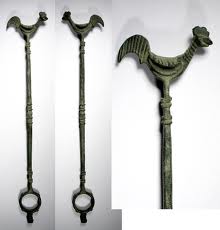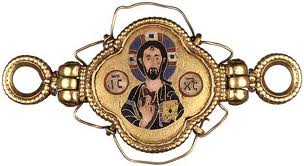|
Artistic characteristic of Byzantine art began to develop in the Roman Empire as early as the 4th century. As the classical tradition declined in vitality, eastern influences were more widely felt. The founding of Constantinople in 324 created a great new Christian artistic centre for the eastern half of the Empire. Artistic traditions flourished also in rival cities. Constantinople established its supremacy after the fall of Alexandria and Antioch to the Arabs, and Rome to the Goths.

Byzantine art grew from the art of Ancient Greece, and never lost sight of its classical heritage, but was distinguished from it in a number of ways. The most profound of these was that the humanist ethic of Ancient Greek art was replaced by a Christian ethic. If the purpose of classical art was the glorification of man, the purpose of Byzantine art was the glorification of God, and of His Son, Jesus.
Enamel, ivory, and metalwork objects of Byzantine workmanship were highly prized throughout the Middle Ages; many such works are found in the treasuries of Western churches. Most of these objects were reliquaries or devotional panels, although an important series of ivory caskets with pagan subjects has also been preserved. Byzantine silks, the manufacture of which was a state monopoly, were also eagerly sought and treasured as goods of utmost luxury.

Byzantine artifacts included Eastern influences in style and the use of special glass tesserae called smalti, manufactured in northern Italy. These were made from thick sheets of coloured glass. Smalti have a rough surface and contain tiny air bubbles.
They are sometimes backed with reflective silver or gold leaf. Whereas Roman mosaics were mostly used as floors, the Byzantines specialised in covering walls and ceilings. The smalti were ungrouted, allowing light to reflect and refract within the glass. Also, they were set at slight angles to the wall, so that they caught the light in different ways. The gold tesserae sparkle as the viewer moves around within the building.
Several shining examples of secular architecture survive from these early centuries, including vestiges of an atrium in the Great Palace in Constantinople, decorated with a lavish mosaic program representing daily life and the riches of the empire. Also surviving from the capital are the remains of two aristocratic homes, the palaces of Antiochus and of Lausos.
Other great ancient cities of the empire, including Antioch and Ephesos, also preserve remains from this secular building tradition. For ecclesiastical architecture in the early Byzantine period, domed churches, the most important being Constantinople's Church of Hagia Sophia, and other domed sacred buildings began to appear in greater number alongside traditional basilica forms, first seen in the large-scale churches sponsored by Emperor Constantine I in the early fourth century.
In the 700s and early 800s, the Iconoclastic controversy raged over the proper use of religious images, resulting in the destruction of icons in all media, especially in the capital of Constantinople.
|

![]()

